Shrinking RFSQ volunteer numbers ‘won’t cope’ with catastrophic bushfire, warns whistleblower
A state minister says any suggestion Queensland is unprepared for the coming bushfire season is an insult to volunteers, but an RSFQ whistleblower disagrees.
Emergency Services
Don't miss out on the headlines from Emergency Services. Followed categories will be added to My News.
Experienced rural firefighters have left the service in droves, with fears the dwindling number of volunteers will now struggle to cope with the catastrophic bushfire season ahead, a senior brigade member says.
A month after a bombshell report came out warning two-thirds of Queensland had an increased bushfire threat this season, homes have been evacuated and thousands of hectares have burnt, as a depleted Rural Fire Service is being asked to hold the hose up against terrible odds.
Over the weekend, homes were evacuated in Emerald and Beerwah, as bushfires burn through national parks and state forests, while a senior Rural Fire Service Queensland (RFSQ) volunteer warns the brigades had lost effectiveness.

RFSQ has seen its volunteer numbers dwindle to 26,000 brigade members, dropping 10,000 volunteers in four years, with a little more than 1000 trucks left in its arsenal this season.
This is despite being tasked with protecting 93 per cent of the state, compared to the government-run Queensland Fire and Emergency Service’s (QFES) coverage of metropolitan areas which makes up about 7 per cent in addition to bushfire attendance.
The RSFQ’s diminishing volunteer numbers and $101m budget are significantly dwarfed by neighbouring NSW, which boasts a monster 70,000-strong volunteer force and drew from a whopping $780m funding pool last year.
The RSFQ whistleblower volunteer said experienced brigade members were leaving the service in droves, and it would struggle to cope with even a modest season, let alone a catastrophic one.
“It’s frustrating for us because we’re losing control, members and effectiveness,” he said.
“Volunteers numbers are dropping like crazy, and the scary part about it is it hides the drop in capability because the numbers that are leaving are the experienced ones.
“More training is available but we just don’t get it. Even a fairly modest season will give us trouble.”

Assistant Commissioner Gary McCormack said the Beerwah fire had burned through 350ha and was “contained but not controlled” as of 5pm Monday. He said the fire could continue to burn for several days and further challenges would arise on Wednesday and Thursday with increased temperatures and a north-westerly wind change forecast.
The RSFQ whistleblower volunteer said the fires ripping through Beerwah would “only get worse”, with a combination of pine trees and the weather forecast making it almost impossible to put out, putting volunteers at risk of burnout.
“It’s a real worry actually,” he said.
“There’s over 55 crews there and about 45 of them are rural volunteers, and you just can’t keep up that sort of an effort for very long – people burn out.
“Beerwah State Forest is all planted pines; they’re very flammable, so given the weather forecast, it’s going to be hard to stop.
“I suspect the government wishes they built the fire trucks they were meant to over the last three years if this keeps going.”
Last month, QFES Commissioner Greg Leach said volunteer firefighters were “well prepared, well trained and increasingly better equipped to deal with the risks that they’re facing”, and that he was happy with the mitigation burning completed, given the challenging weather conditions.
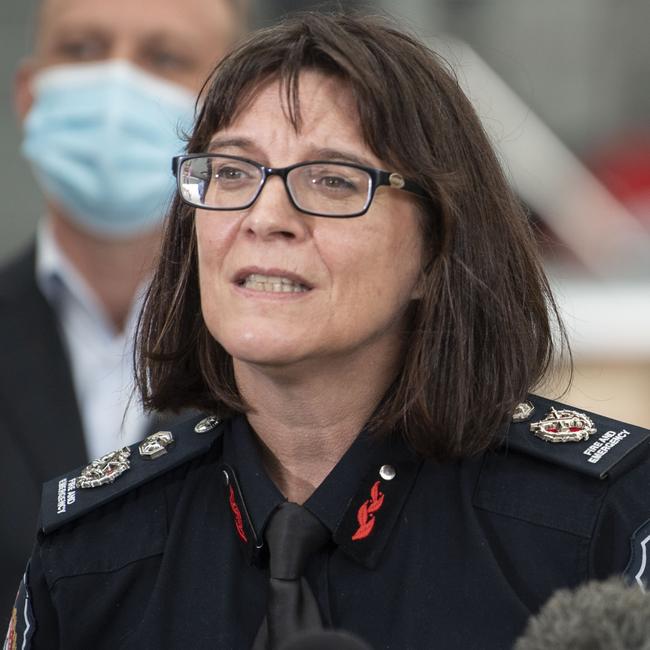
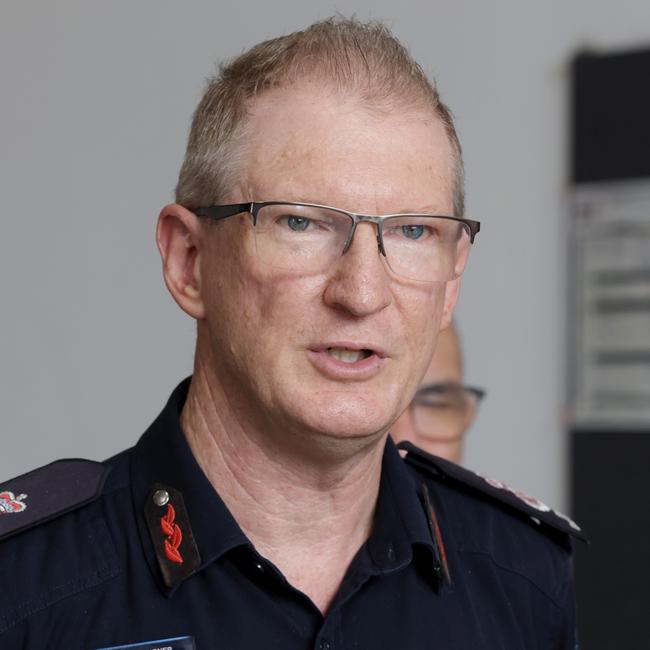
Deputy QFES Commissioner Joanne Greenfield said after the intense start to the season, she still had “high levels of confidence” in the state’s fire fighting capacity and reassured that the service had good fatigue management practices in place for volunteers.
“What you’ve seen from these early fires, we’ve responded strongly,” she said.
“Our early response is our indication of our capacity.”
Ms Greenfield said QFES had been expecting the severe season and were able to prepare.
“Were always preparing, it’s never done,” she said.
“This year we’ve burned over 170,000ha.”
But Rural Fire Brigades Association Queensland (RFBAQ) general manager Justin Choveaux said brigades would be put to the test this season as huge chunks of state-owned land had not been maintained, nor were rail corridors or roadside burns completed.
The national bushfire outlook report warns of exceptionally high fuel loads across Queensland following La Nina, significantly increasing bushfire risk, spread and severity.
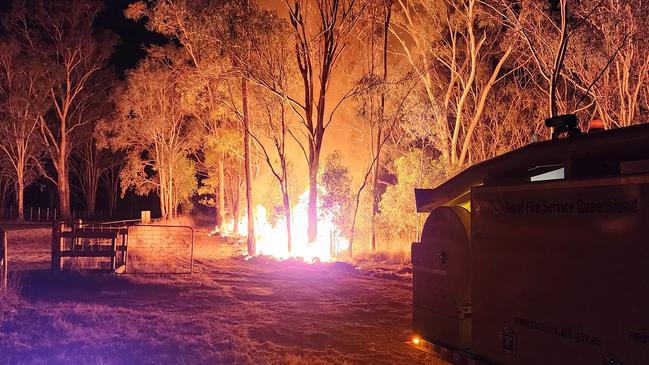
“This is only the start,” Mr Choveaux said.
“A majority of the land – 66 per cent – is owned by the Crown, the state, and they’re just not managing their risk,” Mr Choveaux said.
“They’ve got only got really two choices which is to get more people to manage their risk or get less land, or let a third party in to manage the land.
“We need a statewide policy on roadside burning because right now, brigades are only there to help those burns, they aren’t the landholder.
“Roadsides, railway corridors, all those things that can be used as a fire break are now an ignition point.”
As of September 18, three National Parks in the Glass House Mountains, Burrum Coast and Carnarvon, and Fairbairn State Forest, remain on fire.
Opposition fire and emergency services spokesman Dale Last said rural residents had been caught off guard when Commissioner Leach announced last month that it was “too late” to keep burning, saying residents were simply told ‘no’ at “the last moment”.
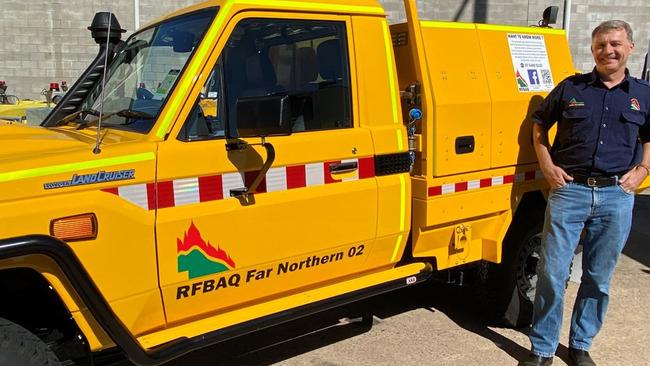
But Fire and Emergency Services Minister Mark Ryan said any suggestion Queensland was unprepared was an insult to the entire firefighting community.
“Fire mitigation programs occur all year round and have been ramped up over the last 18 months following significant rain events and increased vegetation,” he said.
“Queensland’s firefighting crews and volunteers are committed to minimising the community impacts of bushfires, and any suggestion they do not adequately serve the community is an insult to the brave men and women.”
But the senior volunteer firefighter disagreed, saying much of the hazard-reduction burns had been purely “cosmetic” and the main risk was government-owned land.
“It’s very frustrating; there’s so little reduction happening, we’re totally reactive,” he said.
“The main fire risk is government-owned land.
“When those fires start, there’s nothing we can do to stop them.”
A 2021 independent review by KPMG into QFES found the allocation of corporate services was skewed to support the fire and rescue service which received 86 per cent of support while volunteers received only 6 per cent – about one eight the amount of support NSW volunteers receive.

Mr Choveaux said the volunteer service had been run down since losing independence in 1989, but could ascend to NSW “monster capacity” level if it was given legislative autonomy, and its own budget.
He said brigades will be pushing for both sides of politics to commit to giving the RFSQ independence regardless of who wins the 2024 election.
“If you find yourself playing a game you can’t win, what we’ve learned for the last 30 years is to change the game, and that’s what we’re doing,” he said.
“Minister Mark Ryan is the first person in decades who’s come along and acknowledged we have a problem.
“Before the next term of government, we would like written undertakings that RFSQ will become independent with its own chief officer reporting directly to the minister and its own legislation and budget.
The RFS also would like a bigger slice of the emergency levy intake, which raises about $800 million per year from ratepayers and government contribution.
“There’s only one government department that raises its own money, the fire service,” Mr Choveaux said.
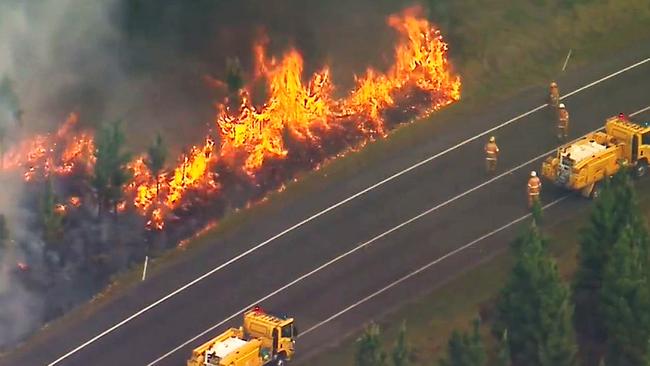
“They’ve been harvesting it for decades, and they just spend it on themselves.
“Right now we’re going to a model that is a semi independent Rural Fire Service but still in the fire and rescue department that levies all the money.
“We don’t want government funds to be taken out of another department and given to us, just us getting our share of the money for the intent that it was raised.”
FIRE LIST
*As of September 18
- Glass House Mountains National Park fire:
Areas affected: Beerwah, Caloundra West, Aura
- Serene Valley fire – moving towards Serene Court, Nome.
Areas affected: Properties between Elliot Springs, Bentley Dr and Zinc Rd
- Brady Rd fire – moving towards Chisholm Trail
Areas affected: Properties between Brady Rd and Kavenagh Crt, including Chisholm Trail and Glenrowan Dr
- Fingerboard Rd fire
Areas affected: Mount Tom and surrounding areas including Gorge Rd, Lowmead and Boyne Valley
- Fairbairn State Forest fire (under control)
Areas affected: Properties along Selma Rd, Emerald
- Churchill Mine Rd fire
Areas affected: Howard, Burgowan and surrounds
- Burrum Coast National Park fire
Areas affected: Coonarr and surrounds
- Ayton Rd, Miles fire (under control)
Areas affected: Miles and surrounds
- Bluewater and Yabulu fires (multiple fires)
Affected areas: Bluewater, Yabula and surrounds
- Gumlow Rd and Hervey Range Rd fire
Areas affected: Alice River, Rangewood and surrounds
- Carnarvon National Park fire (expected to burn for weeks)
Areas affected: Carnarvon Park




